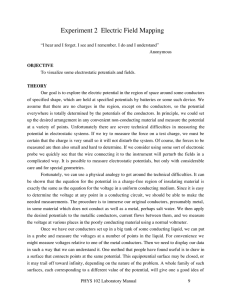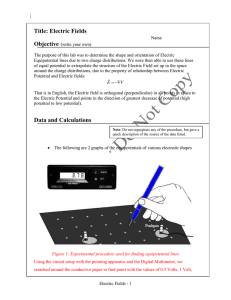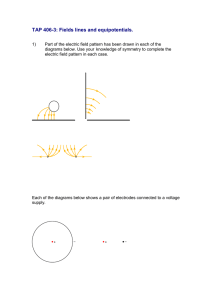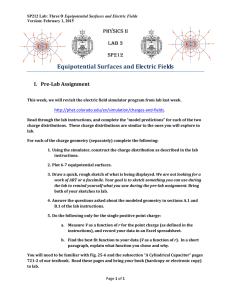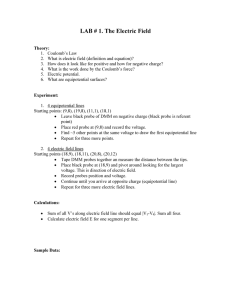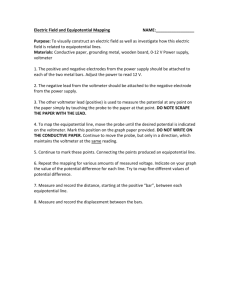Electric Field Mapping
advertisement
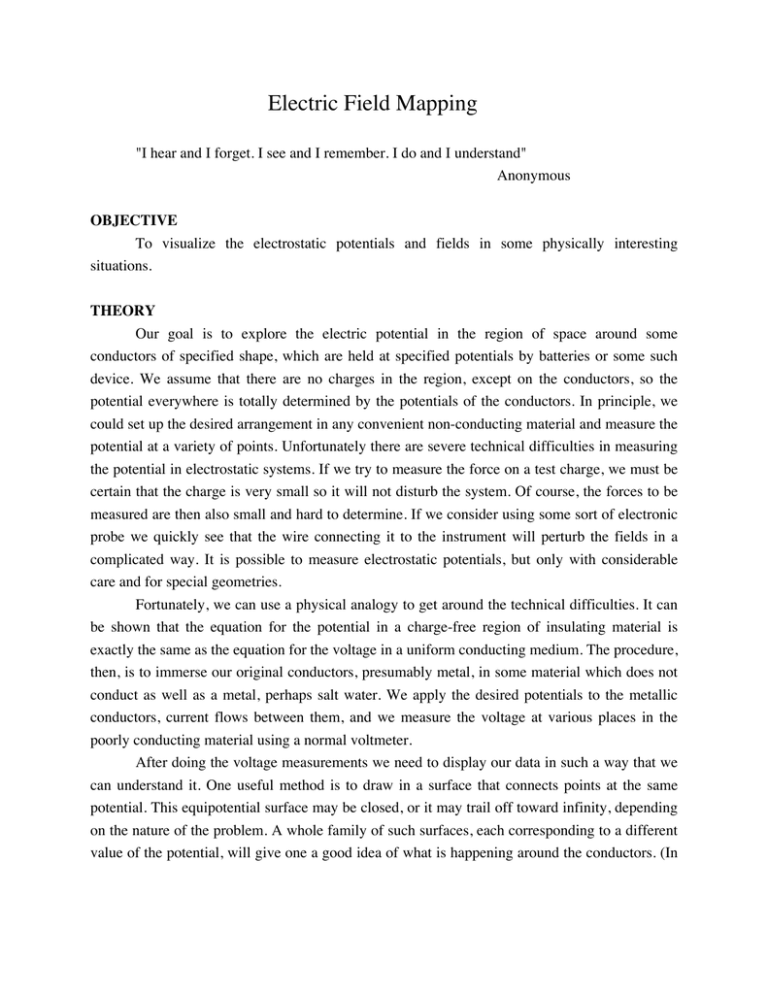
Electric Field Mapping "I hear and I forget. I see and I remember. I do and I understand" Anonymous OBJECTIVE To visualize the electrostatic potentials and fields in some physically interesting situations. THEORY Our goal is to explore the electric potential in the region of space around some conductors of specified shape, which are held at specified potentials by batteries or some such device. We assume that there are no charges in the region, except on the conductors, so the potential everywhere is totally determined by the potentials of the conductors. In principle, we could set up the desired arrangement in any convenient non-conducting material and measure the potential at a variety of points. Unfortunately there are severe technical difficulties in measuring the potential in electrostatic systems. If we try to measure the force on a test charge, we must be certain that the charge is very small so it will not disturb the system. Of course, the forces to be measured are then also small and hard to determine. If we consider using some sort of electronic probe we quickly see that the wire connecting it to the instrument will perturb the fields in a complicated way. It is possible to measure electrostatic potentials, but only with considerable care and for special geometries. Fortunately, we can use a physical analogy to get around the technical difficulties. It can be shown that the equation for the potential in a charge-free region of insulating material is exactly the same as the equation for the voltage in a uniform conducting medium. The procedure, then, is to immerse our original conductors, presumably metal, in some material which does not conduct as well as a metal, perhaps salt water. We apply the desired potentials to the metallic conductors, current flows between them, and we measure the voltage at various places in the poorly conducting material using a normal voltmeter. After doing the voltage measurements we need to display our data in such a way that we can understand it. One useful method is to draw in a surface that connects points at the same potential. This equipotential surface may be closed, or it may trail off toward infinity, depending on the nature of the problem. A whole family of such surfaces, each corresponding to a different value of the potential, will give one a good idea of what is happening around the conductors. (In mapping land surfaces lines are used to connect points of equal elevation on the surface of the earth. What we have is also a topographic map, but in one more dimension.) We can take the analysis a step further, and derive the electric field from the equipotential ! ! surfaces. Recall that the potential is found by integrating E • dx between two points. We can find ! the electric field by reversing this argument. Consider an arbitrary small displacement dx from a point on an equipotential surface. The largest change in potential after the displacement will occur when the displacement is perpendicular to the surface. For a displacement in any other direction we would lose some of the change by moving parallel to a surface where the potential ! ! does not change, by definition. But the change in potential for this displacement is just E • dx ! ! ! and the maximum of the dot product occurs when E is parallel to dx . It must be that E is ! always perpendicular to the equipotential surfaces. The magnitude of E is then given by the rate of change of the potential with displacement. (The vector derivative in space is called the ! gradient of E .) This result means that we can draw electric field lines by finding a line perpendicular to the equipotential surface, extending the line to the next surface, and repeating. Other lines are found by starting at other points. So far we have implied that our problem is three dimensional. Drawing three dimensional equipotential surfaces, one inside another, is tricky, so we will simplify the situation by introducing some symmetry. The problems we will actually work on will represent very long conductors with constant cross sections. An example is shown in Fig. 1. Unless we get near the ends, any slice through this type of system will look exactly like any other slice. Furthermore, the electric field must be in the plane of the slice because there is nothing to make it prefer either direction out of the plane. This means that all the field lines stay within the plane of observation. The equipotential surfaces must then be perpendicular to the plane of observation, and we only Plane of observation Fig. 1 A pair of long rods, each carrying positive charge. The resulting system of equipotentials (lines) and electric fields (arrows) are drawn for the surface indicated. PHYS 112 Electric Field Mapping 2 need to plot lines where the equipotential surfaces cut the plane of observation. Figure 1 shows a typical plot. The effect of the symmetry is to make our problem two-dimensional, and much simpler. EXPERIMENTAL PROCEDURE The experiment will be done on a sheet of resistance paper, which corresponds to the plane of observation in Fig. 1. Resistance paper consists of heavy paper impregnated with a carbon-containing conducting mixture. When properly manufactured the resistance of the paper is uniform, as we require. Charged objects can be simulated by painting the desired shape onto the resistance paper with a metallic paint. The paint does not conduct as well as a solid piece of metal, but the conductivity is a few orders of magnitude better than that of the resistance paper so it will serve our purposes. Because of the symmetry of the problems we are considering, no currents would flow normal to the plane of observation in a three dimensional model. The fact that no current can flow perpendicular to the resistance paper is therefore irrelevant, and we have a good simulation of the desired situation. A typical experimental arrangement is shown in Fig. 2. A current source is connected to two terminals attached to the painted shapes on the resistance paper. Two precautions: Do not slide the probe on the resistance paper, as this may tear it; Do not mark the paper since that would change the resistivity and distort the patterns. To use the digital multimeter, DMM, as a voltmeter connect leads to the terminals marked V! and COM and set the large knob to point at the V with the solid and dashed lines over it (the V with a squiggle denotes AC voltage). The DMM automatically chooses a range and displays the voltage. More detailed instructions can be found on the lab web page. There are at least two ways to find equipotentials. You can follow a line by choosing a convenient voltage, and then locating several points on the resistance paper at the chosen voltage. The reference grid on the resistance paper will help you transfer the locations of the Resistance Paper + Power Supply DMM Fig. 2. Connections for field mapping of the ridge and tree model. PHYS 112 Electric Field Mapping 3 equal-voltage points to a drawing of the electrode pattern on ordinary paper. When you have located enough points, sketch in the equipotential line. By repeating this procedure for several equally-spaced voltages, you can map out the potential surfaces rather completely. Alternatively, you can measure the voltages at a regular grid of points and then interpolate to find equipotential lines as desired. This method is awkward for people, but it is easy to implement with a computer. The voltmeter can also be used to measure the rate of change of the potential directly. Hold the two probes of the voltmeter a fixed distance apart. The displacement from one probe tip ! to the other is your dx . If you now touch the pair of probes to the surface, the voltmeter will read !V. By orienting the probes to find the maximum !V, you will find (approximately) the direction ! and magnitude of E . Your results with this method should be qualitatively consistent with those from the equipotentials. Ridge and tree pattern Start your measurements with the ridge and tree pattern, setting the power supply for about 10.0 V between the ground and the storm cloud. (Because our model forces 2D symmetry it is really a row of “trees”.) Manually trace a few equipotentials near the ground line on the resistance paper and draw them on the supplied copy of the electrode pattern. Using the equipotential plot, explain where the electric fields will be largest, and verify your result by directly measuring the field gradient at appropriate places as explained above. You might also sketch in a few field lines to reinforce your discussion. The locations of large electric fields are of interest because the air will break down electrically (spark) when the field is sufficiently large, leading to a lightning discharge in that vicinity. Would it be advisable to stand on a hill under a thundercloud? Pointed object Next you should examine the fields around the pointed object shown in Fig. 3. Connect the power supply between the two circles and set it for 10.0 V. Manually trace a few Resistance Paper + DMM - Power Supply Fig. 3 Connections for the pointed object. PHYS 112 Electric Field Mapping 4 equipotentials, concentrating on the regions between the dots and the pointed object. Draw some of the electric field lines that connect the circles to each other and to the pointed object, being sure to get the directions correct. Knowing that field lines point from positive to negative charges, what can you infer about the distribution of charge on the pointed object? Can an unconnected conductor, at uniform potential, carry a positive charge at one end and negative one at the other? Why wouldn't the charges neutralize by conduction? Electron lens The last pattern, the outline of a box and a flat plate, represents an electron lens of the sort used in the electron gun of a cathode ray tube. Electrons would be emitted from the back surface of the box portion and then be attracted through the hole toward the plate by a large voltage. The aperture produces an electric field configuration that leads to focusing. To see how this works, connect the box to the ground side of the power supply and the plate to +10 V. Construct equipotentials in the vicinity of the aperture, noting that the situation is sufficiently symmetric that you only need to plot part of the pattern. One of the defining properties of a lens is that it would tend to bring a parallel beam of electrons together at a point. To find out if this happens here we need to trace the paths of some electrons which are emitted perpendicular to the back of the box. We expect that the electric field near the aperture will accelerate the electrons, both increasing their energy and changing their direction. The resulting trajectory can, of course, be calculated exactly from the equations of motion, but it is a rather complicated process. We can get a qualitative understanding by using an exact analogy: Think of the electrons as masses sliding down a hill whose contours are defined by the equipotentials. They will tend to slide downhill, but will not necessarily take the steepest ! path (the direction of E ) because they are already moving forward. Using this idea, try to sketch some trajectories for the alleged lens and show that it is at least plausible that it would focus a parallel stream of electrons. PHYS 112 Electric Field Mapping 5


